Cinque Port Pilots
Pilots in the Cinque Ports were high-status seamen who were vital to the Channel passage trade. The pilots were hired to conduct ships through the dangerous Dover Straits en route to the ports of Holland, Flanders and France. They also piloted ships to the entrances to the Rivers Thames and Medway.
In 1526 the Dover pilots, supervised by the Court of Lodemanage, formed an association known as The Fellowship of the Cinque Port Pilots which was established in order to fend off foreign competition.
The members of the Fellowship took turns in piloting the ships. They were required to be constantly at sea, ready for all incoming and outgoing ships in need of their services. This was hazardous and by the 18th century the dangers were realised and a watchtower was built from which watchmen could keep a look out for passing ships. This was originally a wooden structure on the south pier head, however the wooden tower was demolished when the railway was built in 1844. Later that year a stone Pilot Tower was built at the Pier.
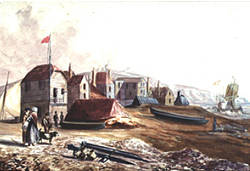
Dover Pilot Tower, Pier District, 1842
In this period, there were four Societies of Mariners in England known as Trinity Houses: Deptford Strond, Hull, Newcastle and Dover. Dover was different from the others; it was not a chartered Trinity House but a Court of Lodesmanage under the commission of the Lord Warden. Despite this Cinque Port Pilots are often referred to in early years as the Fellowship of Pilots of the Trinity House of Dover, Deal and the Isle of Thanet.
These societies were founded to provide pilotage, improve the art and science of Mariners, maintain and improve navigation and to provide care and assistance for distressed or unemployed mariners.
All four societies date back in some form to at least the fourteenth century but the three at Deptford, Hull and Newcastle were formally chartered as Trinity Houses, with Younger Brethren and Elder Brethren ruled by a Master. Deptford was chartered in 1514, Newcastle in 1536 and Hull in 1541. Deptford was the only society which was officially charged with the provision of sea-markers and signals, by an Act of 1566. This Act gave Deptford the sole responsibility for lighthouses and lightships in Britain.
The aforementioned Fellowship of Cinque Port Pilots was officially founded in 1526 to regulate the activities of local seamen who had for centuries assisted ships to pass through the dangerous Straits of Dover to and from the Thames and Medway. Although the official Fellowship was licensed in 1526, an earlier Fellowship of Pilots, or Lodesmen, had been established in 1515. A more informal brotherhood had existed from as early as the thirteenth century and a list of Dover pilot rules exists in the archives dated from 1495. The basic foundations of the Fellowship were laid in 1312 when, after a number of arguments between Pilots, four Wardens were created to make sure each Pilot took his turn and to divide the profits in common.
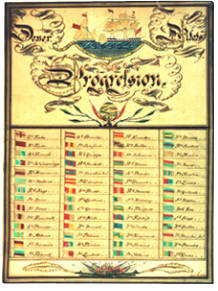
Dover Pilots Progression 1824: A list of Dover pilots with their individual flags
The Pilots were officially licensed by and under the control of the Court of Lodemanage which was administered by the Lord Warden of the Cinque Ports. King William III allowed them to nevertheless elect four wardens from amongst themselves from 1689 and the Pilotage became almost autonomous.
To achieve a licence, pilots had to be knowledgeable seamen able to guide any ship through the Downs and the notorious Goodwin Sands and able to navigate to the Thames, Medway and any channel port. It was usually required that a candidate had had at least seven years at sea as a Master Mariner, thus most pilots were at least twenty-eight years old when licensed. After 1852 the rule became that all pilots had to have had at least five years service as a Master Mariner, but be under the age of thirty-five.
The original enrolment of 1526 was fourteen pilots from Dover, one pilot from Deal and two from Margate. In 1716, Licensed Pilotage was set at fifty pilots for Dover, fifty for Deal and twenty for the Isle of Thanet. In 1801 the number for Dover and Deal was raised to sixty-four, but by 1833 the numbers were limited to fifty-six each at Dover and Deal and twelve in the Isle of Thanet (six each at Margate and Ramsgate)
From 1550 the Cinque Port pilots were divided into two classes: the Upper Book, consisting of the most experienced and longest serving, and the Lower Book, the more junior and last appointed. The Wardens were chosen from the ranks of the Upper Book. The Upper Book also claimed seniority when it came to piloting jobs. Advance to the Upper Book was only possible when a place was vacant and it went to the senior Lower Book member. Lower Book Pilots could only handle ships up to a certain tonnage and draught. After 1852, the classes were redefined as First Class and Second Class with promotion to First Class automatic after one year, pending on examination.
Dover was the most lucrative Cinque Port, consequently most newly licensed pilots started at Ramsgate or Margate and then moved on to Deal or Dover as they gained seniority and vacancies arose. Consequently, pilots moved around the ports quite often; a Dover mariner could move to Ramsgate, then to Deal and then return to Dover.
The Lord Warden and the Court of Lodemanage supposedly regulated the Fellowship and appointed new pilots; however in practice much was left to the Wardens and pilots themselves. A new pilot was admitted in St. James' Church by the bestowing of a 'Branch' on which the Seal of Admiralty and Chancery was fixed. The Pilot was then issued with a licence, which included a physical description of the holder. After 1616, Pilots affairs were overseen by a Jury of the Court of Lodemanage, which consisted of six Dover pilots, four Thanet pilots and two Deal pilots. They met in St. James' Church, Dover.
The Court (and later Trinity House) only licensed pilots, it did not employ them. The pilots themselves were always self-employed. The pilots contributed to a sick pay and pension scheme that they administered themselves as a fellowship. There was also a widow’s benefit that paid £12 per year to pilots’ widows until they re-married.
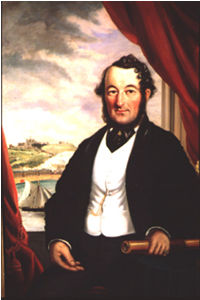
W.A.Y. Marsh, Cinque Port Pilot circa 1875: Killed when the Pilot Cutter Edinburgh was run down 1879
Originally the pilots had lookouts on the shore to watch for signals for a pilot from passing ships. They would then go off in their own bum boats or galleys to the ships wanting pilots or they paid local boatmen to taxi them out. Each had his own personal flag for identification, flown from the mast to indicate “pilot aboard”. From 1852 the cruising system was introduced: pilots would take their turns stationed at sea on a pilot cutter, cruising the shipping lanes for customers.
Later, with steam propulsion, the cutter anchored at a fixed station just off Dungeness, west of Dover. The cutter would anchor and its crew and pilots would be taken on board passing ships as they were needed. Those pilots at the back of the roster might spend many days aboard the cutter awaiting their turn. Alternatively, all fourteen could get jobs within a day and another batch of pilots would have to be brought out of Dover to replenish the cutter. If a ship on its way up the Channel missed the cutter, there would be pilots on duty at the shore stations in Dover, Deal and Thanet ready to go out in boats. This was to ensure that no ships could claim they were unable to secure the services of a pilot, which many would try to do, to avoid the pilotage fees. Hefty fines were imposed on any vessel avoiding pilotage.
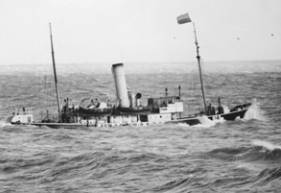
Pilot Cutter No. 6 off Dover circa 1930
All pilots had to be Freemen and churchgoers. Church services were compulsory but as Pilotage could be required at any time, the pilots paid for their own galleries with a separate entrance so that they could leave without disturbing the congregation. Pilot’s galleries were built at St. Mary’s Church in Dover, St. Leonard’s Church in Upper Deal and St. George’s Church in Deal.
In 1590 the pilots organised an annual survey of the channel from the South Foreland to The Nore, to chart the ever-changing channels and sand banks of the Goodwin Sands. This was an important new project, although irregular surveys had commenced in 1568.
In 1853 the Cinque Port Pilots were transferred to the Trinity House of Deptford Strond (London) and the Court of Lodemanage was closed. The Duke of Wellington, as Lord Warden, had taken personal control of the pilots and resisted any change to their organisation. Wellington’s death in 1852 allowed the government to rationalise pilotage. The Cinque Port Pilots were now under the control of the Master and Brethren of Trinity House, Deptford Strond. Despite this change they managed to remain relatively independent. The fifty-six Deal Pilots were gradually transferred to the Dover Station from 1858. The last three were transferred in 1937.
From 1971-1988 the pilots were based at the Folkestone Pilot Tower, which was built that year to replace the cruising cutter off Dungeness. Due to technological advances, such as radio and fast motor launches, the pilots no longer needed to wait at sea but could be called out from port. The Fellowship was still based in Dover but, following the demolition of the Tower to widen the railway, they had moved to offices in Marine Parade on the seafront. In 1988, due to improved radar, communications and traffic control, the Cinque Port Pilots were disbanded and local pilotage passed to harbour and river authorities.
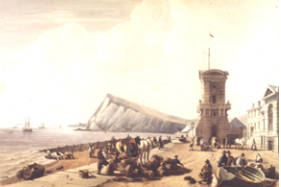
Dover Pilot Tower 1857: Built 1848 and demolished 1913
Surviving records of the Court of Loadmanage, including Pilot’s licences, are held in the Cinque Ports Confederation collection at the Kent Archives Centre: www.kentarchives.org.uk/
Surviving records of the Fellowship of the Cinque Port Pilots are held by Dover Museum.
There were a number of independent organisations that operated sea pilots (as opposed to river or harbour pilots). One was Trinity House of Deptford Strond which licensed 'Outward' pilots who piloted vessels out of the Port of London. The Cinque Ports Pilots of Dover licensed 'Inwards' pilots into the Port of London. Trinity pilots were mostly picked up in London Port but there were a few pilots stationed outside the Thames estuary to catch vessels heading into the English Channel that did not come from London. Surviving records of Trinity House, including Pilots LIcences, are held by the London Metroplitan Archives: www.cityoflondon.gov.uk/things-to-do/history-and-heritage/london-metropolitan-archives
Researched and written by Mark Frost, Dover Museum.